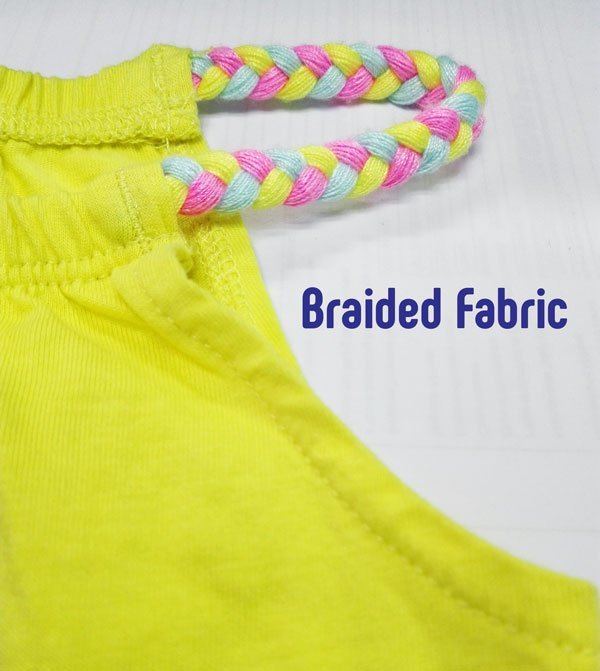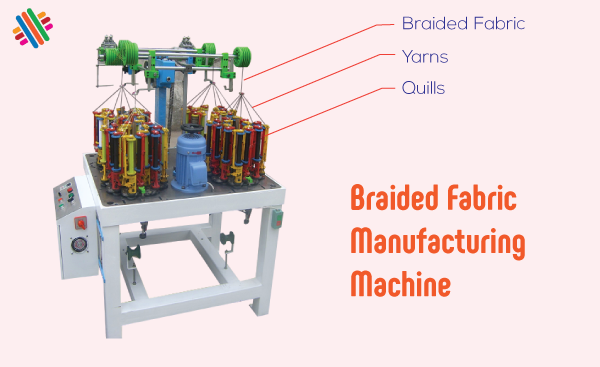Braided Fabric: Definition, Types, Manufacturing Process and End Uses
Last updated on December 23rd, 2025 at 08:43 am
Introduction
The braided fabric is the most uncommon among all the types of fabric used in the fashion industry. Ranging from clothing trims and accessories, it is used for home furnishings and different industrial applications. It is made by intertwining strands of yarn or thread. This special structure makes the fabric strong, durable, and visually appealing. It is also used for making upholstery, DIY projects and crafts.

Definition of Braided Fabric
Braided fabric is a versatile textile created by interlacing or intertwining multiple strands of yarn, bulk filament thread, or strips of different materials. It looks like a girl’s hair braid. This entangled weaving technique produces a durable and visually appealing fabric with a unique texture and strength. Different types of fibre like cotton, nylon, elastomultiester, polyester, and their blends, or even metallic fibres are used to make this fabric.
Properties of Braided Fabric
This fabric has some special properties that make it different from other fabrics. The properties are as follows:
- Strength: These fabrics are known for their high strength. These are suitable for applications where durability and load-bearing capacity are essential.
- Flexibility: The interlacing of yarns in a braided structure provides flexibility. It allows the fabric to bend and conform to different shapes without compromising its strength.
- Abrasion resistance: These fabrics have good resistance to abrasion. This property makes them suitable for applications where the material may be subjected to friction.
- Tensile strength: The unique construction of braided fabrics imparts excellent tensile strength. It makes them suitable for use in ropes, cables, and other applications requiring resistance to pulling forces.
- Elasticity: Depending on the textile raw materials used, these fabrics can represent elasticity. This property allows them to stretch and recover their original shape.
- Dimensional stability: These fabrics often maintain their dimensional stability even under stress, strain or washing. It ensures that they retain their shape and structural integrity.
- Heat resistance: These fabrics have good resistance to heat. It makes them suitable for applications where exposure to high temperatures is a consideration.
- Electrical conductivity or insulation: Depending on the raw materials used, these fabrics can exhibit electrical conductivity or insulation properties. This makes them suitable for applications in electronics or wiring.
- Aesthetic variety: These fabrics come in various patterns and designs, offering aesthetic versatility. This makes them suitable for decorative applications in addition to functional uses.
- Water resistance: Some fabrics can be treated or made with water-resistant materials. It provides protection against moisture absorption. It also enhances their performance in outdoor or wet environments.
Types of Braided Fabric
There many types of braided fabric as follows:

- Round braided fabric: It is also known as circular braided fabric. This type of fabric is made by intertwining multiple strands around a thread or yarn in a circular pattern. It is used to make drawstrings, ropes, rugs, baskets and home decor.
- Flat braided fabric: In flat braids, the strands are interlaced in a two-dimensional pattern, creating a flat and wide structure. It is used to make belts, shoelaces, straps, piping and other trimmings.
- Tubular braided fabric: This type of fabric is made by weaving strands in a tube-like shape, giving it a hollow and lightweight construction. It is mainly used for reinforcement purposes.
- Square braided fabric: It has a square-shaped cross-section pattern which offers a different appearance. It is used for both functional and decorative purposes.
- Diamond braided fabric: It is characterized by a pattern that creates a series of small diamond shapes along the length of the braid. It is used to make ropes and cords.
- Double braided fabric: It consists of an inner core and an outer covering. It provides enhanced strength and durability. This type of fabric is often used in marine ropes and climbing equipment.
- Kumihimo braided fabric: Kumihimo is a traditional Japanese braiding technique that involves a systematic arrangement of strands to create intricate patterns. These braids are often used as jewellery, belts and decorative items.
- Cable braided fabric: It is designed to resemble the structure of cables. It is commonly used in the manufacturing of cables for electrical wiring and other applications.
- Fishtail braided fabric: It is known as herringbone braids. It has a pattern that resembles the bones of a fish. It is used for decorative purposes and in fashion.
- Rope braided fabric: It looks like traditional ropes. It is used in applications such as handles, cords, and decorative elements.
Manufacturing Process
The braiding process involves four major steps as follows:

- Quilling: Quilling refers to the process of winding or coiling yarn onto bobbins or quills. This involves preparing the yarn or fibers for the subsequent steps in the manufacturing process.
- Mounting: Mounting involves setting up the equipment and machinery required for the braiding process. This step includes securing the quills or bobbins onto the braiding machine.
- Braiding: In this step, the prepared yarn or fibers are interlaced or braided together to form the fabrics. Different types of braiding machines are used to create different types of patterns and structures.
- Folding: After braiding, the fabric is cut according to the desired length. Then the fabric is folded into a specific configuration or shape.
End Uses of Braided Fabric
Braided fabrics come in a variety of types, depending on their end uses. Some popular end uses as follows:

- Bracelets: These bracelets have gained popularity as trendy fashion accessories. These bracelets often feature vibrant colors, intricate patterns, and a secure fastening mechanism. Different types of fibres like cotton, nylon, polyester, synthetic leather, and even precious metals are used to make these bracelets.
- Baskets: These baskets can give you enough storage space for a variety of items in your home. You can place it next to the sofa or utilise it in the bathroom for laundry. You may also position it outdoors for storing blankets and cushions.
- Rugs: These rugs offer a cosy and inviting feel to any room. The interlaced fabric strips create a dense and durable surface that can withstand heavy foot traffic. These can add the final touch to any interior design style. Different types of rugs in different colors, patterns, and sizes are available on the market that you can try.
- Belts: These belts can give a special touch to any outfit. Various types of designs, widths, colors and patterns are available on the market. These can provide both functionality and fashion.
- Necklace: Braided fabric necklaces are a fashionable alternative to traditional metal or chain necklaces. These lightweight accessories feature intricately woven patterns that can integrate beads, pendants, or charms. They offer a stylish and bohemian look. These are perfect for adding a special touch to any outfit.
- Room essentials braided fabric hangers: These hangers serve as decorative and functional elements in organizing and hanging clothes. These add a touch of style to room essentials. These help you to create a cohesive and organized closet space.
- Headband: These headbands are a great choice for making hair. These help to place hair while adding a stylish accessory to any hairstyle. These headbands are versatile and come in various widths and patterns. These allow individuals to express their unique sense of style.
- Trim: These trims are used to enhance the style of clothing, accessories, or home decor items. They can be attached to the edges of garments, curtains, pillow covers, or tablecloths. These add a decorative and personal touch.
- Adjustable scarf: These scarves provide both warmth and style during colder months. The braided design adds visual interest and texture to the scarf, making it a fashionable accessory.
- Ropes: These ropes are widely used in various applications due to their strength and flexibility. They can be utilized in boating, camping, gardening, or even for decorative purposes. These ropes are resistant to fraying and offer a reliable alternative to traditional ropes.
- Placemats: These placemats are a practical and decorative addition to dining tables. They protect surfaces from spills and scratches while adding a touch of elegance to the dining experience. These placemats can be customised with different colors and patterns to suit various table settings.
Conclusion
Braided fabric is a unique textile item with a rich history and a wide range of end uses. From trendy bracelets to functional baskets and durable rugs, the manufacturing process and types of braided fabric allow for endless possibilities. Whether used for fashion, home decor, or practical purposes, braided fabric adds a touch of uniqueness and style to any project.




The braided fabric is the most uncommon among all the types of fabric used in the fashion industry.